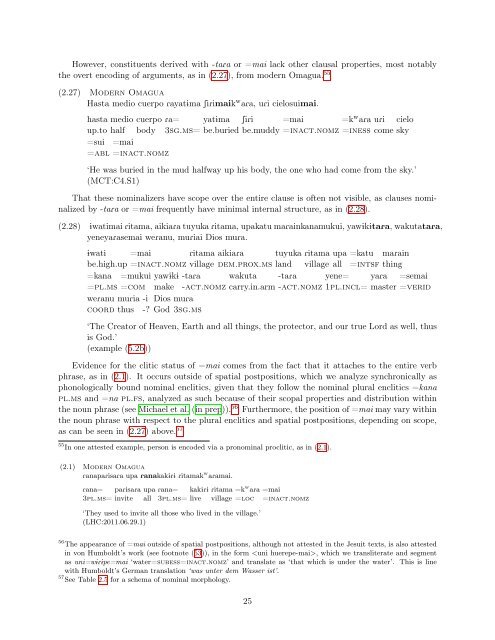draft manuscript - Linguistics - University of California, Berkeley
draft manuscript - Linguistics - University of California, Berkeley
draft manuscript - Linguistics - University of California, Berkeley
You also want an ePaper? Increase the reach of your titles
YUMPU automatically turns print PDFs into web optimized ePapers that Google loves.
However, constituents derived with -taRa or =mai lack other clausal properties, most notably<br />
the overt encoding <strong>of</strong> arguments, as in (2.27), from modern Omagua. 55<br />
(2.27) Modern Omagua<br />
Hasta medio cuerpo Rayat1ma SiRimaik w aRa, uRi cielosuimai.<br />
hasta medio<br />
up.to half<br />
=sui<br />
=abl<br />
cuerpo<br />
body<br />
=mai<br />
=inact.nomz<br />
Ra= yat1ma SiRi =mai =k w aRa uRi cielo<br />
3sg.ms= be.buried be.muddy =inact.nomz =iness come sky<br />
‘He was buried in the mud halfway up his body, the one who had come from the sky.’<br />
(MCT:C4.S1)<br />
That these nominalizers have scope over the entire clause is <strong>of</strong>ten not visible, as clauses nominalized<br />
by -taRa or =mai frequently have minimal internal structure, as in (2.28).<br />
(2.28) 1watimai Ritama, aikiaRa tuyuka Ritama, upakatu maRainkanamukui, yaw1k1taRa, wakutataRa,<br />
yeneyaRasemai weRanu, muRiai Dios muRa.<br />
1wati =mai Ritama aikiaRa tuyuka Ritama upa =katu maRain<br />
be.high.up =inact.nomz village dem.prox.ms land village all =intsf thing<br />
=kana =mukui yaw1k1 -taRa wakuta -taRa yene= yaRa =semai<br />
=pl.ms =com make -act.nomz carry.in.arm -act.nomz 1pl.incl= master =verid<br />
weRanu muRia -i Dios muRa<br />
coord thus -? God 3sg.ms<br />
‘The Creator <strong>of</strong> Heaven, Earth and all things, the protector, and our true Lord as well, thus<br />
is God.’<br />
(example (5.2b))<br />
Evidence for the clitic status <strong>of</strong> =mai comes from the fact that it attaches to the entire verb<br />
phrase, as in (2.1). It occurs outside <strong>of</strong> spatial postpositions, which we analyze synchronically as<br />
phonologically bound nominal enclitics, given that they follow the nominal plural enclitics =kana<br />
pl.ms and =na pl.fs, analyzed as such because <strong>of</strong> their scopal properties and distribution within<br />
the noun phrase (see Michael et al. (in prep)). 56 Furthermore, the position <strong>of</strong> =mai may vary within<br />
the noun phrase with respect to the plural enclitics and spatial postpositions, depending on scope,<br />
as can be seen in (2.27) above. 57<br />
55 In one attested example, person is encoded via a pronominal proclitic, as in (2.1).<br />
(2.1) Modern Omagua<br />
RanapaRisaRa upa Ranakak1R1 Ritamak w aRamai.<br />
Rana= paRisaRa upa Rana= kak1R1 Ritama =k w aRa =mai<br />
3pl.ms= invite all 3pl.ms= live village =loc =inact.nomz<br />
‘They used to invite all those who lived in the village.’<br />
(LHC:2011.06.29.1)<br />
56 The appearance <strong>of</strong> =mai outside <strong>of</strong> spatial postpositions, although not attested in the Jesuit texts, is also attested<br />
in von Humboldt’s work (see footnote (53)), in the form , which we transliterate and segment<br />
as uni=w1R1pe=mai ‘water=subess=inact.nomz’ and translate as ‘that which is under the water’. This is line<br />
with Humboldt’s German translation ‘was unter dem Wasser ist’.<br />
57 See Table 2.5 for a schema <strong>of</strong> nominal morphology.<br />
25
















